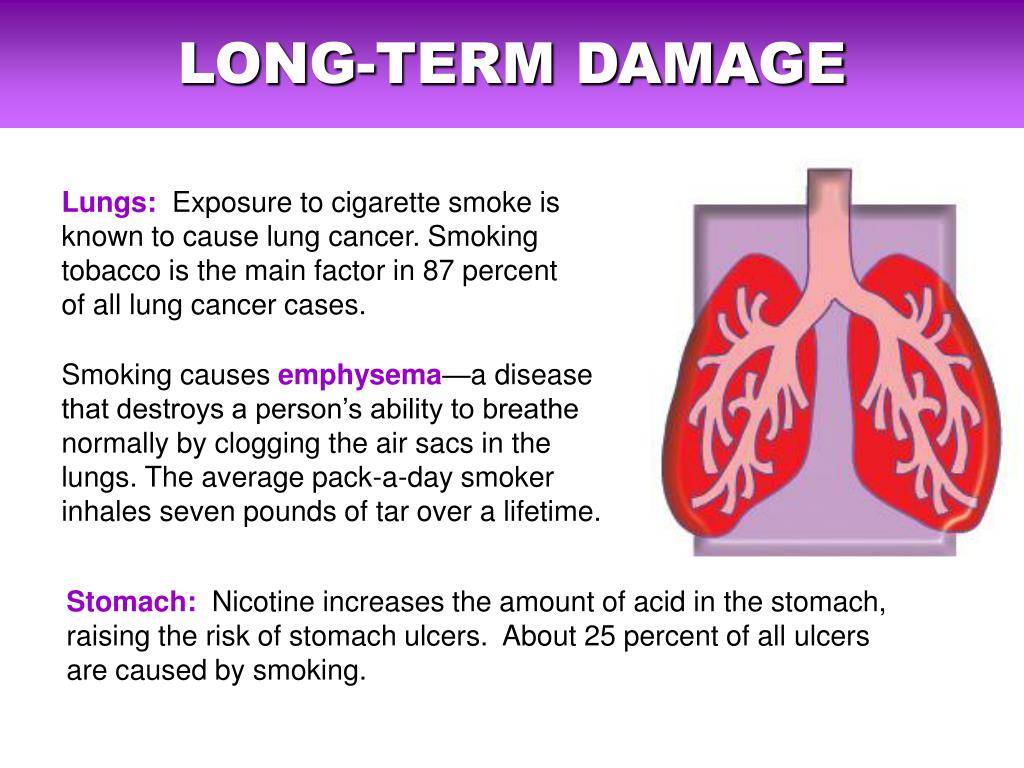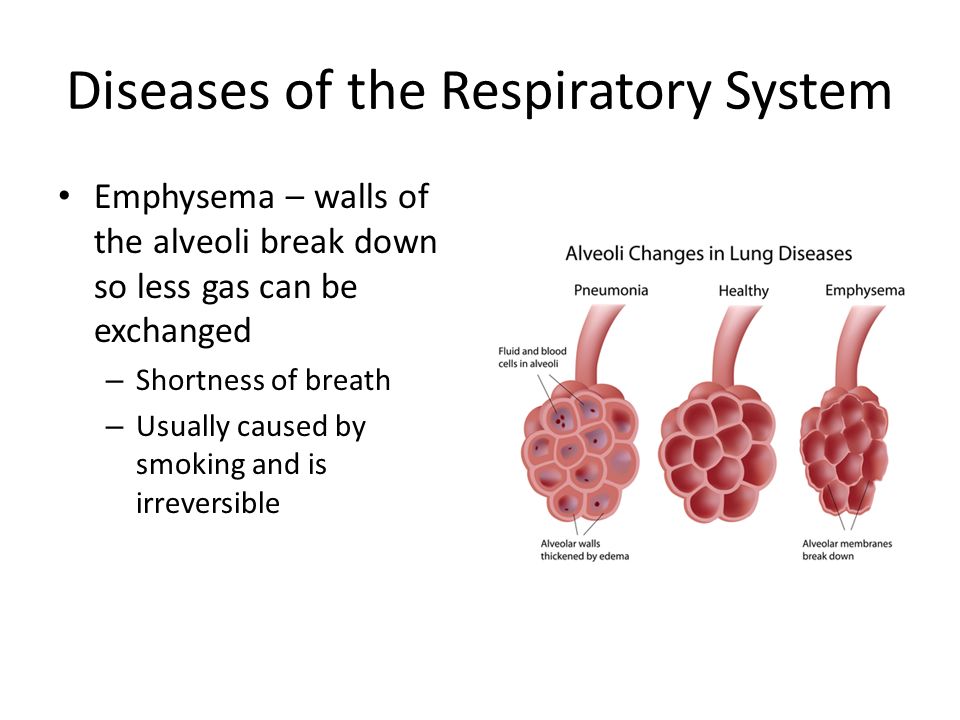What Causes Emphysema Besides Smoking: Unveiling COPD Risk Factors
What are the main causes of COPD besides smoking. How does exposure to harmful substances affect lung health. Can genetic factors contribute to the development of COPD. What occupational hazards increase the risk of emphysema.
Understanding COPD: Beyond the Smoke
Chronic Obstructive Pulmonary Disease (COPD) is a progressive lung condition that significantly impairs breathing. While smoking remains the primary culprit, it’s crucial to recognize that non-smokers can also develop this debilitating condition. Let’s explore the various factors that contribute to COPD development, shedding light on lesser-known causes and risk factors.
The Silent Threat: Secondhand Smoke and COPD
Can exposure to secondhand smoke lead to COPD? Research indicates that prolonged exposure to secondhand smoke can indeed increase the risk of developing COPD. Living with a smoker or working in smoke-filled environments can subject individuals to harmful chemicals that damage lung tissues over time. While the risk may be lower compared to active smokers, it’s a significant concern that shouldn’t be overlooked.

Protecting Yourself from Secondhand Smoke
- Establish smoke-free zones in your home and workplace
- Avoid public areas where smoking is prevalent
- Educate family members and colleagues about the dangers of secondhand smoke
- Support smoke-free policies in your community
Environmental Pollutants: The Hidden Danger in the Air
How do environmental pollutants contribute to COPD? Air pollution, both indoor and outdoor, plays a significant role in the development and exacerbation of COPD. Prolonged exposure to particulate matter, ozone, nitrogen dioxide, and other airborne toxins can cause inflammation and damage to the lungs and airways. Urban dwellers and those living in heavily industrialized areas are particularly at risk.
Common Environmental Pollutants Linked to COPD
- Vehicle emissions
- Industrial fumes
- Biomass fuel smoke
- Construction dust
- Chemical vapors
To minimize exposure to environmental pollutants, consider using air purifiers in your home, avoiding outdoor activities during high pollution days, and supporting clean air initiatives in your community.

Occupational Hazards: When Your Job Puts Your Lungs at Risk
Which occupations are associated with an increased risk of COPD? Certain professions expose workers to harmful substances that can damage lung tissue over time. Industries such as mining, construction, textile manufacturing, and agriculture have been linked to higher rates of COPD among workers. Prolonged exposure to dust, chemicals, and fumes in these environments can lead to chronic lung inflammation and obstruction.
High-Risk Occupations for COPD Development
- Coal miners
- Construction workers
- Welders
- Textile workers
- Farmers and agricultural workers
- Chemical plant employees
If you work in a high-risk industry, it’s crucial to follow safety protocols, use proper protective equipment, and undergo regular health check-ups to monitor your lung function.
The Genetic Factor: Alpha-1 Antitrypsin Deficiency
Can genetics play a role in COPD development? While rare, a genetic condition called Alpha-1 Antitrypsin (AAT) deficiency can lead to COPD, even in non-smokers. AAT is a protein that protects the lungs from damage. Individuals with AAT deficiency lack this crucial protein, making their lungs more susceptible to injury and inflammation.
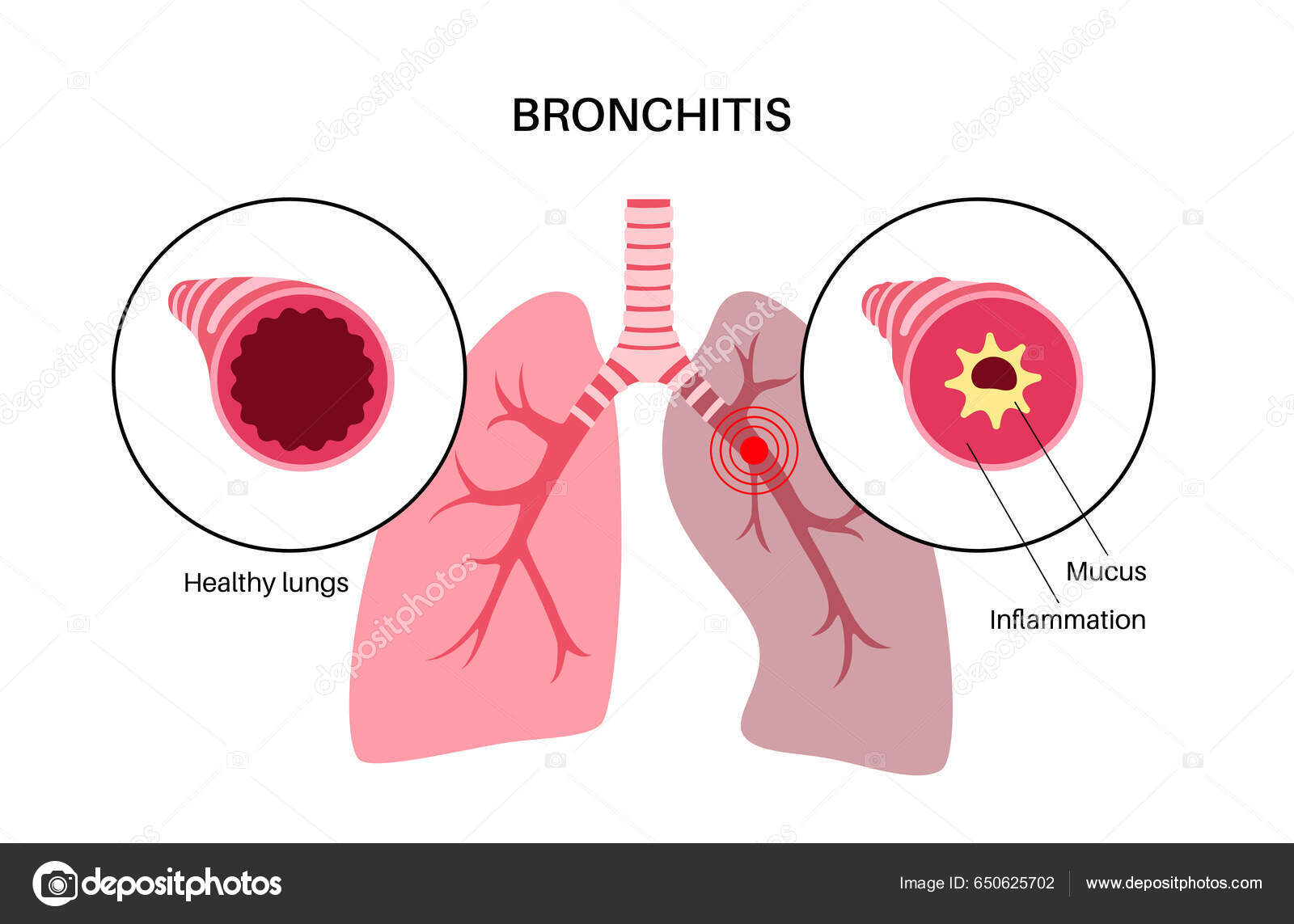
Signs You May Have AAT Deficiency
- Development of COPD at a young age (under 45)
- COPD without a history of smoking
- Unexplained liver problems
- Family history of COPD or liver disease
If you suspect you may have AAT deficiency, consult your healthcare provider about genetic testing. Early detection can lead to better management and potentially slow the progression of COPD.
The Asthma-COPD Connection: Unraveling the Link
How does asthma increase the risk of developing COPD? Asthma, particularly when poorly controlled, can contribute to the development of COPD. Chronic inflammation and repeated airway obstruction associated with asthma can lead to permanent changes in lung structure and function over time. This phenomenon, known as airway remodeling, can result in persistent airflow limitation characteristic of COPD.
Managing Asthma to Reduce COPD Risk
- Adhere to prescribed asthma medications
- Identify and avoid asthma triggers
- Develop an asthma action plan with your healthcare provider
- Monitor lung function regularly
- Maintain a healthy lifestyle to support overall lung health
Effective asthma management is crucial in preventing the progression to COPD. Regular check-ups and open communication with your healthcare provider can help keep your asthma under control and minimize long-term lung damage.
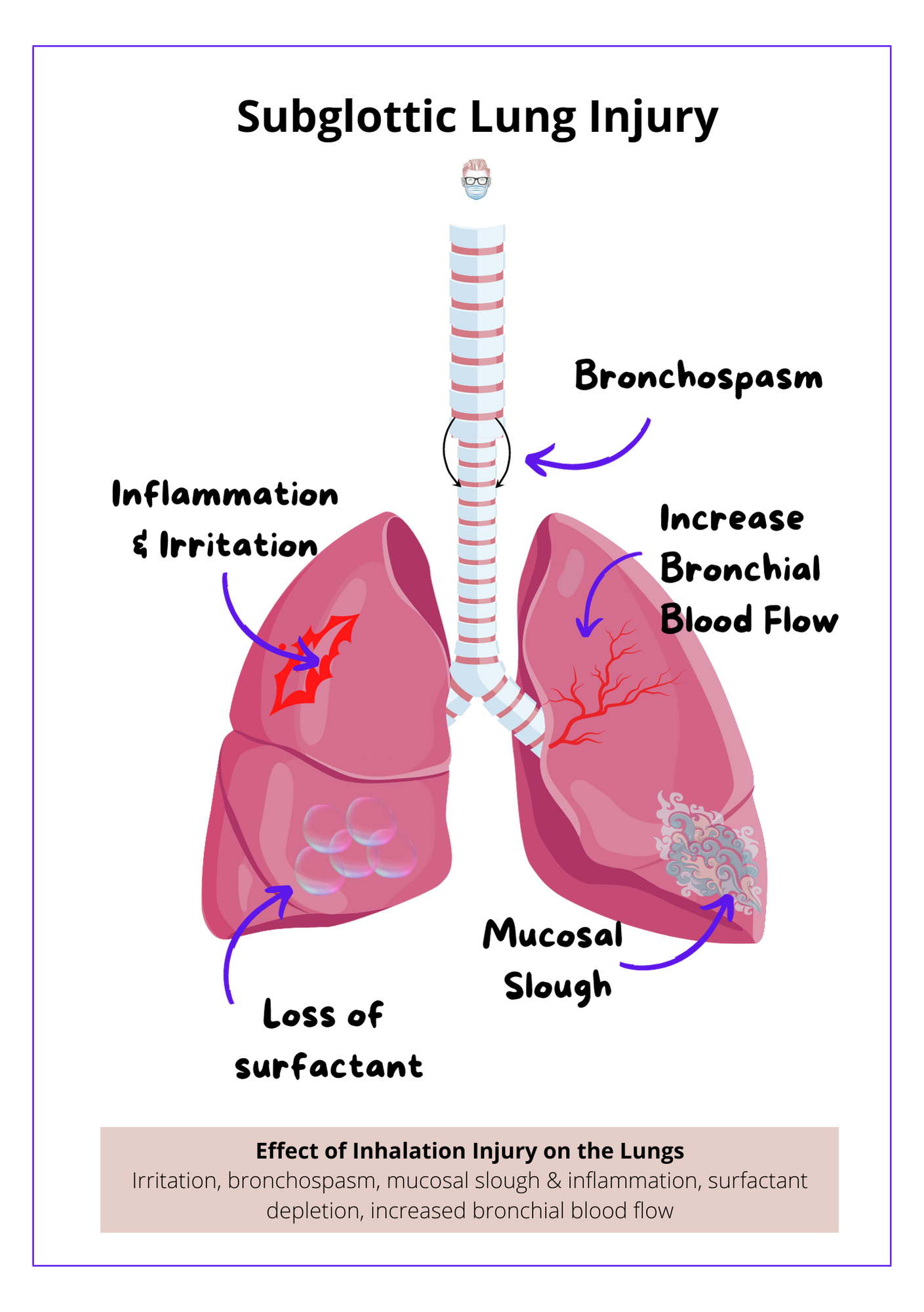
Childhood Respiratory Infections: A Long-Term Impact
Can childhood respiratory infections increase the risk of COPD in adulthood? Research suggests that severe or frequent respiratory infections during childhood may contribute to an increased risk of COPD later in life. These infections can potentially interfere with normal lung development and lead to long-term changes in lung structure and function.
Protecting Children’s Lung Health
- Ensure children receive all recommended vaccinations
- Promote good hygiene practices to prevent infections
- Create a smoke-free environment for children
- Encourage regular physical activity to support lung development
- Seek prompt medical attention for respiratory illnesses
While not all childhood respiratory infections lead to COPD, protecting children’s lung health early on can help reduce their risk of developing respiratory problems in adulthood.
Age and COPD: Understanding the Relationship
Why does the risk of COPD increase with age? As we age, our lungs naturally lose some of their elasticity and efficiency. This gradual decline in lung function, coupled with cumulative exposure to risk factors over time, makes older adults more susceptible to developing COPD. Most people begin to experience COPD symptoms after the age of 40, although the disease can develop earlier, especially in cases of genetic predisposition or severe environmental exposure.

Maintaining Lung Health as You Age
- Stay physically active to support lung function
- Avoid smoking and exposure to secondhand smoke
- Eat a balanced diet rich in antioxidants
- Stay up-to-date with vaccinations, especially flu and pneumonia shots
- Undergo regular health check-ups, including lung function tests
While aging is inevitable, taking proactive steps to protect your lung health can help reduce the risk of developing COPD or slow its progression if you’ve already been diagnosed.
The Impact of Socioeconomic Factors on COPD Risk
How do socioeconomic factors influence COPD development and progression? Socioeconomic status plays a significant role in COPD risk and outcomes. Individuals from lower socioeconomic backgrounds may face increased exposure to environmental pollutants, have limited access to healthcare, and be more likely to work in high-risk occupations. Additionally, factors such as poor nutrition, overcrowded living conditions, and higher stress levels can contribute to increased susceptibility to COPD and its complications.

Addressing Socioeconomic Disparities in COPD
- Improve access to preventive healthcare services
- Implement workplace safety regulations in high-risk industries
- Promote smoking cessation programs in underserved communities
- Enhance air quality in urban and industrial areas
- Provide education on lung health and COPD prevention
Tackling socioeconomic disparities is crucial in reducing the overall burden of COPD and ensuring equitable access to prevention, diagnosis, and treatment services.
The Role of Nutrition in COPD Risk and Management
Can diet influence COPD risk and progression? While nutrition alone cannot prevent COPD, a balanced diet plays a crucial role in maintaining overall lung health and managing the condition. Certain nutrients have been associated with better lung function and reduced inflammation, potentially lowering the risk of COPD or slowing its progression.
Nutrients Beneficial for Lung Health
- Omega-3 fatty acids: Found in fish, flaxseeds, and walnuts
- Antioxidants: Present in colorful fruits and vegetables
- Vitamin D: Obtained from sunlight exposure and fortified foods
- Magnesium: Found in leafy greens, nuts, and whole grains
- Fiber: Present in fruits, vegetables, and whole grains
Maintaining a healthy weight is also crucial, as both obesity and underweight status can negatively impact lung function and COPD management. Consult with a registered dietitian to develop a nutrition plan tailored to your specific needs and health status.

Emerging Research: The Gut-Lung Axis and COPD
How does gut health relate to COPD risk? Recent studies have highlighted the potential connection between gut health and lung function, known as the gut-lung axis. The composition of the gut microbiome may influence systemic inflammation and immune responses, potentially affecting lung health and COPD risk. While research in this area is still emerging, it opens up new avenues for understanding COPD development and potential therapeutic approaches.
Supporting Gut Health for Lung Function
- Consume a diverse range of plant-based foods
- Include fermented foods in your diet
- Consider probiotic supplements under medical guidance
- Reduce intake of processed foods and added sugars
- Stay hydrated to support overall gut function
While more research is needed to fully understand the gut-lung connection in COPD, maintaining a healthy gut microbiome through diet and lifestyle choices may contribute to overall lung health.
Prevention Strategies: Safeguarding Your Lungs
What steps can individuals take to reduce their risk of developing COPD? While some risk factors for COPD are beyond our control, there are several proactive measures that can significantly reduce the likelihood of developing this condition:

Key COPD Prevention Strategies
- Quit smoking or never start
- Avoid exposure to secondhand smoke
- Use proper protective equipment in high-risk work environments
- Improve indoor air quality with proper ventilation and air purifiers
- Get regular exercise to maintain lung function
- Manage existing health conditions, particularly asthma
- Stay up-to-date with vaccinations, especially for respiratory illnesses
- Eat a balanced diet rich in antioxidants and anti-inflammatory foods
- Undergo regular health check-ups, including lung function tests
- Reduce exposure to air pollution when possible
By implementing these strategies, individuals can significantly reduce their risk of developing COPD and maintain optimal lung health throughout their lives. Remember, prevention is always better than cure when it comes to chronic respiratory conditions.
Early Detection: The Key to Better COPD Management
Why is early detection crucial in COPD management? Identifying COPD in its early stages can significantly impact the course of the disease and improve long-term outcomes. Early intervention allows for prompt implementation of lifestyle changes, appropriate medical treatments, and prevention of further lung damage. Unfortunately, COPD is often underdiagnosed, with many individuals dismissing early symptoms as normal signs of aging or the effects of being “out of shape.”
:max_bytes(150000):strip_icc()/shoulder-pain-and-lung-cancer-2249407-01-5b854f80c9e77c0050771415.png)
Warning Signs of COPD
- Persistent cough, often with mucus
- Shortness of breath, especially during physical activities
- Wheezing or chest tightness
- Frequent respiratory infections
- Unexplained fatigue
- Blue lips or fingernail beds (cyanosis)
If you experience any of these symptoms, especially if you have known risk factors for COPD, it’s crucial to consult with a healthcare provider. Spirometry, a simple breathing test, can help diagnose COPD and assess its severity. Early detection and management can help preserve lung function and improve quality of life for individuals with COPD.
The Future of COPD Research and Treatment
What advancements are on the horizon for COPD prevention and treatment? The field of COPD research is dynamic, with ongoing studies exploring new avenues for prevention, early detection, and treatment. Some promising areas of research include:
Emerging Trends in COPD Research
- Personalized medicine approaches based on genetic profiles
- Novel anti-inflammatory therapies
- Stem cell treatments for lung regeneration
- Advanced imaging techniques for early detection
- Development of new inhaler technologies
- Exploration of the gut-lung axis in COPD pathogenesis
- Artificial intelligence applications in COPD management
While these research areas hold promise, it’s important to note that developing new treatments and preventive strategies takes time. In the meantime, focusing on known prevention methods and adhering to current treatment guidelines remains crucial for individuals at risk of or living with COPD.

Understanding the various causes and risk factors associated with COPD beyond smoking is essential for comprehensive prevention and management strategies. By addressing environmental, occupational, genetic, and lifestyle factors, we can work towards reducing the global burden of this debilitating respiratory condition. Whether you’re at risk for COPD or simply interested in maintaining optimal lung health, staying informed and taking proactive steps can make a significant difference in your respiratory well-being.
Smoking & 7 Other Things That May Cause COPD
Written by R. Morgan Griffin
- Common Causes of COPD
- Risk Factors for COPD
- How Does COPD Affect My Lungs?
- Tips to Help Prevent COPD
Chronic obstructive pulmonary disease, or COPD, is an ongoing lung disorder that makes it hard to breathe.
The main cause of COPD is smoking, but you don’t have to be a smoker to get it. Other things can lead to this condition, which leaves you feeling short of breath.
Learn more about what causes it, who has the greater odds of getting it, and how you can lower your chances.
COPD is most likely to result from:
- Cigarette smoke: This is by far the most common reason people get COPD. You can also get it from tobacco products, such as cigar and pipe smoke, especially if you breathe in the smoke.
- Secondhand smoke: Even if you aren’t a smoker, you can get COPD from living with one.

- Pollution and fumes: You can get COPD from air pollution. Breathing in chemical fumes, dust, or toxic substances at work can also cause it.
- Your genes: In rare cases, people with COPD have a defect in their DNA, the code that tells your body how to work properly. This defect is called “alpha-1 antitrypsin deficiency,” or AAT deficiency. When you have this, your lungs don’t have enough of a protein needed to protect them from damage. This can lead to severe COPD. If you or a family member had serious lung problems — especially at a young age — ask your doctor about testing for AAT deficiency.
- Asthma: Poorly controlled asthma can raise the risk for developing COPD.
Things that can make you more likely to get COPD include:
- Smoking: This is the most common cause of COPD.
- Asthma: Your chances are even higher if you have asthma and you smoke.

- Age: Most people are 40 or older when their symptoms start up.
- Certain jobs: If your job puts you around dust, chemical fumes, or vapors, your lungs can get damaged. Damage can also come from prolonged exposure to air pollution.
- Infections: If you had lots of respiratory infections in childhood, you have a greater chance of COPD in adulthood.
Inside your lungs are tiny sacs called alveoli. They fill up like balloons every time you take a breath. The oxygen in these sacs passes into your bloodstream, and then your lungs push out the stale air.
When you have COPD, your lungs don’t work as they should. Long-term irritation from smoke or other pollutants can damage them for good.
When this happens, the walls between the alveoli break down. Your airways get swollen and clogged with mucus. It becomes harder to push out the stale air. You don’t get enough fresh oxygen with each breath.
In most cases, this happens very slowly.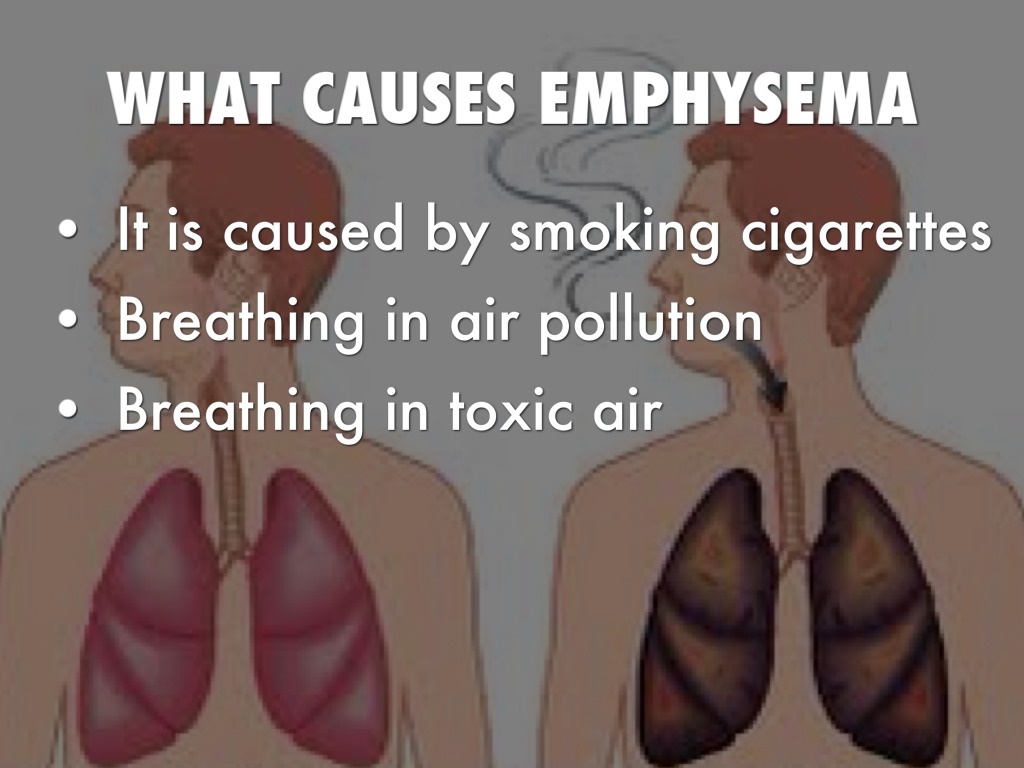 The symptoms may come on over time. It may be years before you even notice them.
The symptoms may come on over time. It may be years before you even notice them.
You can’t heal the damage that has already happened in your lungs. But you can make changes to slow down the damage or stop it from getting worse.
- Don’t smoke. This is the best way to prevent COPD or slow it down if you already have it. If you don’t smoke, don’t start. If you smoke, quit. Ask your doctor, family, and friends to help.
- Avoid breathing in things that bother your lungs. As much as possible, stay away from fumes, toxins, secondhand smoke, and dust.
- Watch out for colds, viruses, and infections. If you have COPD, even a common cold can lead to severe problems. During cold season, wash your hands well and often. Use hand sanitizer if you cannot wash your hands. Try not to be around people who are sick.
- Get vaccines. Protect your lungs against the flu and pneumonia.

- Ask your doctor about being tested for AAT deficiency. A blood test can find this type of COPD that you get from your parents at birth. It isn’t common, but if you have serious lung symptoms with no clear cause like smoking, your doctor may check. You may also need testing if you get emphysema (a type of COPD) before age 46 or have a family member with AAT deficiency. Medicines as well as other treatments and lifestyle changes can keep you breathing easier if you do have COPD.
Top Picks
Chronic obstructive pulmonary disease (COPD) – Causes
Chronic obstructive pulmonary disease (COPD) happens when the lungs and airways become damaged and inflamed.
It’s usually associated with long-term exposure to harmful substances such as cigarette smoke.
Things that can increase your risk of developing COPD are discussed in this section.
Smoking
Smoking is the main cause of COPD and is thought to be responsible for around 9 in every 10 cases.
The harmful chemicals in smoke can damage the lining of the lungs and airways. Stopping smoking can help prevent COPD from getting worse.
Some research also suggests that being exposed to other people’s cigarette smoke (passive smoking) may increase your risk of COPD.
Fumes and dust at work
Exposure to certain types of dust and chemicals at work may damage the lungs and increase your risk of COPD.
Substances that have been linked to COPD include:
- cadmium dust and fumes
- grain and flour dust
- silica dust
- welding fumes
- isocyanates
- coal dust
The risk of COPD is even higher if you breathe in dust or fumes in the workplace and you smoke.
The Health and Safety Executive has more information about occupational causes of COPD
Air pollution
Exposure to air pollution over a long period can affect how well the lungs work and some research suggests it could increase your risk of COPD.
But the link between air pollution and COPD is not conclusive and research is continuing.
Genetics
You’re more likely to develop COPD if you smoke and have a close relative with the condition, which suggests some people’s genes might make them more vulnerable to the condition.
People with alpha-1-antitrypsin deficiency can go on to develop COPD. Alpha-1-antitrypsin is a substance that protects your lungs. Without it, the lungs are more vulnerable to damage.
People who have an alpha-1-antitrypsin deficiency usually develop COPD at a younger age – particularly if they smoke.
Asthma + Lung UK has more information about alpha-1-antitrypsin deficiency
Alpha-1 UK Support Group is for people affected by alpha-1-antitrypsin deficiency
Page last reviewed: 11 April 2023
Next review due: 11 April 2026
what is it and how to treat. The role of smoking
Figures presented during World No Tobacco Day, an annual event dedicated to raising awareness of the importance of quitting, show that almost one in four Italians (1% of the population) will smoke in 2022: a percentage increase of 4 percentage points item. compared with the pre-pandemic period from 24.2
Smoking is now well known to be an important (if not the main) risk factor for the development of many diseases (eg cancer).
These include lung emphysema.
It is estimated that it affects about 210 million people worldwide and can cause 3 million deaths each year.
In the past, emphysema was more common in men who were heavy smokers.
However, in recent years, the scenario has changed: even female smokers, who are now more numerous than in the past, suffer from emphysema and at the same time, much more often than men, also have chronic obstructive bronchopathy, a disease associated with emphysema, as we shall see. below.
Early intervention, especially to prevent a decline in lung function, is not only possible but necessary.
What is pulmonary emphysema and its types
Emphysema is a disease of the pulmonary alveoli: the tissue they are composed of degrades with a decrease in their ability to exchange oxygen and carbon dioxide with the blood.
Alveolar tissue is destroyed, sharply reducing the useful surface area for gas exchange: once destroyed, 7 alveoli can no longer return to their previous state, they are irreparably damaged.
From a morphological point of view, there are several types of pulmonary emphysema:
- centrilobular (or centroacinar) pulmonary emphysema, the most common form in smokers;
- panlobular (or panacinous) emphysema;
- paraseptal emphysema;
- irregular emphysema.

What are the reasons
There can be many reasons, but in the West smoking (tobacco use) is the main reason (90% of cases).
Thus, causes include:
- cigarette smoking, including passive smoking
- inhalation of toxic substances;
- be a child of smoking mothers during pregnancy;
- air pollution;
- recurrent respiratory infections;
- prematurity and low birth weight;
- Alpha-1 antitrypsin deficiency.
- Cigarette smoke and respiratory inflammation
Inhalation of toxic fumes such as cigarette smoke damages cells and promotes inflammation.
This leads to the elimination of damaged cells and the simultaneous inhibition of natural repair mechanisms, which leads to the development of emphysema.
Lungs lose elasticity, alveoli rupture, creating large air spaces that reduce the surface area needed by the body to exchange oxygen and carbon dioxide.
This process, associated with chronic inhalation of harmful substances such as cigarette smoke, often co-occurs with a condition of chronic airway inflammation called chronic bronchitis leading to the complex pathology known as chronic obstructive bronchopathy.
Let’s not forget that persistent infections of the lower respiratory tract also cause inflammation and, by increasing the secretion of mucus, can contribute to the course of the disease.
Emphysema symptoms
One of the earliest symptoms of emphysema is definitely shortness of breath (or shortness of breath), which gradually worsens, first with strenuous exercise, then with daily tasks such as climbing stairs , and finally even at rest.
In addition, the progressive destruction of the alveoli and pulmonary capillaries, as well as the lack of oxygen, can lead to an increase in pressure in the pulmonary artery, which can lead to right ventricular failure (this is called “pulmonary heart failure”). .
.
Finally, patients with emphysema are more likely to develop pneumothorax, which is a tear in the lung tissue that causes the lung to collapse.
In addition to shortness of breath and heart failure, they may experience:
- dry cough with chronic sputum;
- fatigue;
- heart problems;
- fever;
- cyanosis of lips and nails.
How the diagnosis is made: tests to be done
Emphysema usually affects smokers around the age of 50 and is insidiously manifested by shortness of breath on exertion, which the patient often attributes to age or a sedentary lifestyle.
Unfortunately, patients often go to the doctor only after an attack of bronchitis, after which they can no longer breathe as before, and by this time the disease is already in an advanced stage.
For this reason, it is very important for general practitioners to be proactive in looking for disease in their smokers over 40 years of age by finding out if they have frequent coughs or shortness of breath during physical activity.
Persistent cough and shortness of breath: the first signs to look out for
It is therefore very important that a patient who smokes consult his doctor if he has
- cough almost every day for at least 3 months a year for 2 consecutive years
- shortness of breath during physical exertion, which did not bother him a year ago.
The family doctor will be able to take a correct history and conduct an objective examination, and then arrange appropriate examinations, possibly with the help of a pulmonologist, in order to determine the best therapy and prevention of complications.
spirometry
The most important test for diagnosing chronic obstructive pulmonary disease is spirometry, which will show the pattern of expiratory flow obstruction.
Related messages
This is a simple, non-invasive, inexpensive test that is easy to perform and interpret.
The test subject simply blows hard into the device, which measures airflow, starting with a deep breath.
Normally, a healthy person should be able to empty 70 to 80% of all the air they can exhale in the first second of the maneuver.
Patients with airway obstruction or loss of lung compliance, as occurs with emphysema, take much longer.
This obstruction usually has little or no response to a bronchodilator.
Further Functional Tests
Once the pattern has been identified, emphysema can be confirmed by performing other functional tests such as global spirometry and alveolar-capillary diffusion, which evaluate both lung hyperinflation and the loss of gas exchange efficiency typical of emphysema.
Computed tomography of the lung can also show areas of alveolar destruction at a very early stage.
In more severe cases, pulse oximetry measurement will provide information on blood oxygenation and, if necessary, arterial hemogas analysis, blood sampling from the wrist), it will be useful to check the correct gas exchange in the alveoli, the level of oxygen in the blood and predict the correct function of the lungs.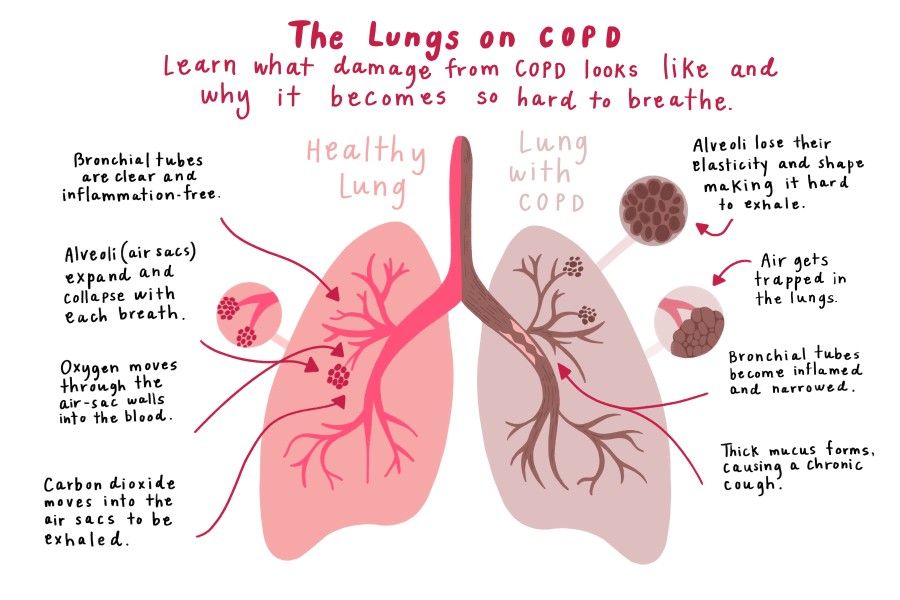
How to treat emphysema
There is no special treatment that can restore lost breathing function, the only thing that can change the natural course of emphysema is to stop smoking.
Smoking cessation reverses the accelerated decline in lung function, slowing down the progressive course of the disease.
Unfortunately, quitting smoking is not easy, but today we have smoke-free centers that can not only help in the fight against nicotine addiction, but also provide psychological support to counter psychological addiction.
This combined approach significantly improved smoking cessation success in motivated individuals.
In addition to quitting smoking, patients should be encouraged to lead a healthy lifestyle, maintain regular physical activity, and protect against influenza and pneumococcal vaccination.
Medical therapy for emphysema
Other treatments available are bronchodilators, which are used to reduce expiratory flow limitation by reducing lung hyperinflation and eliminating shortness of breath.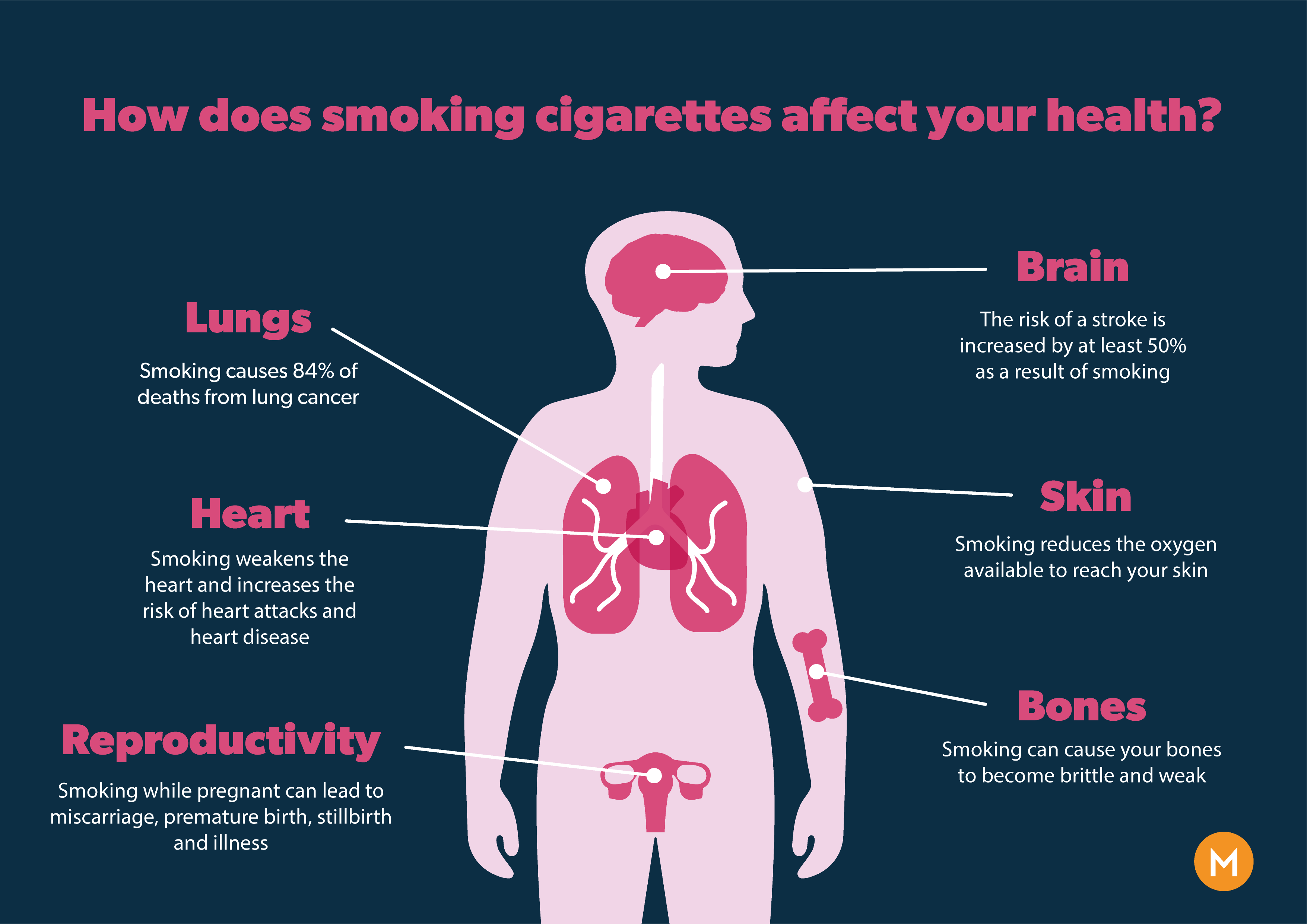
Anti-inflammatory drugs are also used, which in some patients can reduce bronchial obstruction and prevent bronchial exacerbation and thus preserve lung function.
These medicines can relieve symptoms and thus improve patients’ quality of life.
Antibiotics, on the other hand, are indicated only during exacerbations of chronic bronchitis or pneumococcal pneumonia.
Other treatments
Patients with severe respiratory failure should be given supplemental oxygen for at least 18 hours a day to prevent “pulmonary heart failure” (right ventricular failure).
On the other hand, all patients in whom shortness of breath interferes with their daily activities are indicated for respiratory rehabilitation.
The latter consists of a multidisciplinary program aimed at improving exercise tolerance through physiotherapy interventions to strengthen limb and respiratory muscles, as well as providing educational and nutritional support to help patients cope with their chronic disability.
Possible complications
The most common complications are exacerbations, defined as episodes of worsening shortness of breath and coughing, sometimes severe enough to threaten the patient’s life.
These episodes can further worsen lung function, resulting in a higher severity.
Exacerbations are often caused by viral, sometimes bacterial infections or pneumonia.
Sometimes they can also be complicated by heart attacks or episodes of heart failure.
Therefore, greater efforts are needed to find patients with this disease at the earliest stage, immediately start secondary prevention of smoking cessation, initiate appropriate drug therapy and interventions aimed at changing the lifestyle of patients so that the development of the disease can be counteracted. from the very beginning.
Read also:
Emergency Live Even more… Live: download your newspaper’s new free app for IOS and Android
Oxygen-ozone therapy: for which pathologies is it indicated?
Hyperbaric oxygen in wound healing
Venous thrombosis: from symptoms to new drugs
Prehospital intravenous access and fluid resuscitation for severe sepsis: an observational cohort study
What is intravenous cannulation (IV)? 15 steps of procedure
Nasal cannula for oxygen therapy: what it is, how it is done, when to use it
source:
GSD
Site map
|




